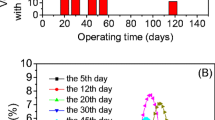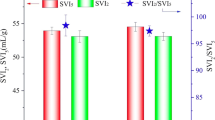Abstract
Novel aerobic granular sludge membrane bioreactor (GMBR) was established by combining aerobic granular sludge technology with membrane bioreactor (MBR). GMBR showed good organics removal and simultaneous nitrification and denitrification (SND) performances for synthesized wastewater. When influent total organic carbon (TOC) was 56.8–132.6 mg/L, the TOC removal of GMBR was 84.7–91.9%. When influent ammonia nitrogen was 28.1–38.4 mg/L, the ammonia nitrogen removal was 85.4–99.7%, and the total nitrogen removal was 41.7–78.4%. Moreover, batch experiments of sludge with different particle size demonstrated that: (1) flocculent sludge under aerobic condition almost have no denitrification capacity, (2) SND capacity was caused by the granular sludge, and (3) the denitrification rate and total nitrogen removal efficiency were enhanced with the increased particle size. In addition, study on the sludge morphology stability in GMBR showed that, although some granular sludge larger than 0.9 mm disaggregated at the beginning of operation, the granular sludge was able to maintain the stability of its granular morphology, and at the end of operation, the amount of granular sludge (larger than 0.18 mm) stabilized in GMBR was more than 56–62% of the total sludge concentration. The partial disaggregation of large granules is closely associated with the change of operating mode from sequencing batch reactor (SBR) system to MBR system.






Similar content being viewed by others
References
APHA (1998) Standard methods for the examination of water and wastewater, 20th edn. American Public Health Association, Washington, DC, USA
Bai R, Leow HF (2002) Microfiltration of activated sludge wastewater—the effect of system operation parameters. Sep Purif Technol 29:189–198
Beun JJ, Hendriks A, van Loosdrecht MCM et al (1999) Aerobic granulation in a sequencing batch reactor. Wat Res 33(10):2283–2290
Beun JJ, Heijnen JJ, van Loosdrecht MCM (2001) N-removal in a granular sludge sequencing batch airlift reactor. Biotechnol Bioeng 75(1):82–92
Beun JJ, van Loosdrecht MCM, Heijnen JJ (2002) Aerobic granulation in a sequencing batch airlift reactor. Wat Res 36(3):702–712
Chu LB, Yang FL, Zhang XW (2005) Anaerobic treatment of domestic wastewater in a membrane-coupled expended granular sludge bed (EGSB) reactor under moderate to low temperature. Process Biochem 40(3–4):1063–1070
Chu LB, Zhang XW, Yang FL et al (2006) Treatment of domestic wastewater by using a microaerobic membrane bioreactor. Desalination 189(1–3):181–192
de Bruin LMM, de Kreuk MK, van der Roest HFR et al (2004) Aerobic granular sludge technology: An alternative to activated sludge? Wat Sci Technol 49(11–12):1–7
de Kreuk MK, van Loosdrecht MCM (2004) Selection of slow growing organisms as a means for improving aerobic granular sludge stability. Wat Sci Technol 49(11/12):9–17
Hu LL, Wang JL, Wen XH et al (2005) The formation and characteristics of aerobic granules in sequencing batch reactor (SBR) by seeding anaerobic granules. Process Biochem 40(1):5–11
Jun BH, Miyanaga K, Tanji Y et al (2003) Removal of nitrogenous and carbonaceous substances by a porous carrier -membrane hybrid process for wastewater treatment. J Biochem Eng 14(1):37–44
Laguna A, Ouattara A, Gonzalez RO et al (1999) A simple and low cost technique for determining the granulometry of upflow anaerobic sludge blanket reactor sludge. Wat Sci Technol 40(8):1–8
Lee W, Kang S, Shin H (2003) Sludge characteristics and their contribution to microfiltration in submerged membrane bioreactors. J Membr Sci 216(1–2):217–227
Li XF, Gao FS, Hua ZZ et al (2005) Treatment of synthetic wastewater by a novel MBR with granular sludge developed for controlling membrane fouling. Separation and Purification Technology 46(1–2):19–25
Lim AL, Bai R (2003) Membrane fouling and cleaning in microfiltration of activated sludge wastewater. J Membr Sci 216:279–290
Liu Y, Liu QS (2006) Causes and control of filamentous growth in aerobic granular sludge sequencing batch reactors. Biotechnol Adv 24:115–127
Liu Y, Tay JH (2002) The essential role of hydrodynamic shear force in the formation of biofilm and granular sludge. Wat Res 36:1653–1665
Liu Y, Tay JH (2004) State of art of biogranulation technology for wastewater treatment. Biotechnol Adv 22(7):533–563
McSwain BS, Irvine RL, Wilderer PA (2004a) The effect of intermittent feeding on aerobic granule structure. Wat Sci Technol 49(11–12):19–25
McSwain BS, Irvine RL, Wilderer PA (2004b) The influence of settling time on the formation of aerobic granules. Wat Sci Technol 50(10):195–202
Picioreanu C, van Loosdrecht MCM, Heijnen JJ (2000) Effect of diffusive and convective substrate transport on biofilm structure formation: a two dimensional modeling study. Biotechnol Bioeng 69:504–515
Qin L, Tay JH, Liu Y (2004) Selection pressure is a driving force of aerobic granulation in sequencing batch reactors. Process Biochem 39:579–584
Tay JH, Liu QS, Liu Y (2001) Microscopic observation of aerobic granulation in sequential aerobic sludge blanket reactor. J Appl Microbiol 91:168–175
van Dijk L, Roncken GCG (1997) Membrane bioreactors for wastewater treatment: the state of the art and new developments. Wat Sci Technol 35:35–41
Wang Q, Du GC, Chen J (2004) Aerobic granular sludge cultivated under the selective pressure as a driving force. Process Biochem 39:557–563
Wang JF, Wang X, Ji M et al (2006) Synchronous nitrification denitrification in granular sludge membrane bioreactor. China Environ Sci 26(4):436–440, (In Chinese)
Wang JF, Wang X, Ji M et al (2007) Sludge characteristics in a sequencing batch aerobic granular sludge membrane bioreactor. Environ Sci 28(5):1033 – 1038, (In Chinese)
Wilderer PA, McSwain BS (2004) The SBR and its biofilm application potentials. Wat Sci Technol 50(10):1–10
Yang SF, Tay JH, Liu Y (2003) A novel granular sludge sequencing batch reactor for removal of organic and nitrogen from wastewater. J Biotechnol 106(1):77–86
Yang W, Cicek N, Ilg J (2006) State-of-the-art of membrane bioreactors: worldwide research and commercial applications in North America. J Membr Sci 270(1–2):201–211
Yeom IT, Nah YM, Ahn KH (1999) Treatment of household wastewater using an intermittently aerated membrane bioreactor. Desalination 124(1–3):193–204
Yu T, Bishop L (1998) Stratification of microbial metabolic processes and redox potential change in an aerobic biofilm studied using microelectrodes. Water Sci Technol 37:195–198
Zhang HM, Xiao JN, Cheng YJ et al (2006) Comparison between a sequencing batch membrane bioreactor and a conventional membrane bioreactor. Process Biochem 41:87–95
Zhu ZZ, Zhou Y, Li XF et al (2006) Characteristics of aerobic granular sludge membrane bioreactor for wastewater treatment. Environ Sci 27(1):57–62, (In Chinese)
Acknowledgment
Financial supports from the National High Technology Research and Development Program of China (Grant No. 2006AA06Z334), the National Natural Science Foundation of China (Grant No. 30600487), and the Science and Technology Development Foundation of Tianjin Higher Institute (Grant No. 20070714) were acknowledged.
Author information
Authors and Affiliations
Corresponding author
Rights and permissions
About this article
Cite this article
Wang, J., Wang, X., Zhao, Z. et al. Organics and nitrogen removal and sludge stability in aerobic granular sludge membrane bioreactor. Appl Microbiol Biotechnol 79, 679–685 (2008). https://doi.org/10.1007/s00253-008-1466-6
Received:
Revised:
Accepted:
Published:
Issue Date:
DOI: https://doi.org/10.1007/s00253-008-1466-6




